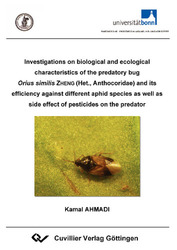| Fachbereiche | |
|---|---|
| Buchreihen (96) |
1378
|
| Nachhaltigkeit |
3
|
| Gesundheitswesen |
1
|
| Geisteswissenschaften |
2365
|
| Naturwissenschaften |
5406
|
| Mathematik | 229 |
| Informatik | 319 |
| Physik | 980 |
| Chemie | 1363 |
| Geowissenschaften | 131 |
| Humanmedizin | 243 |
| Zahn-, Mund- und Kieferheilkunde | 10 |
| Veterinärmedizin | 108 |
| Pharmazie | 147 |
| Biologie | 835 |
| Biochemie, Molekularbiologie, Gentechnologie | 121 |
| Biophysik | 25 |
| Ernährungs- und Haushaltswissenschaften | 45 |
| Land- und Agrarwissenschaften | 1004 |
| Forstwissenschaften | 201 |
| Gartenbauwissenschaft | 20 |
| Umweltforschung, Ökologie und Landespflege | 148 |
| Ingenieurwissenschaften |
1793
|
| Allgemein |
98
|
|
Leitlinien Unfallchirurgie
5. Auflage bestellen |
|
Erweiterte Suche
Investigations on biological and ecological characteristics of the predatory bug Orius similis ZHENG (Het., Anthocoridae) and its efficiency against different aphid species as well as side effect of pesticides on the predator
Kamal Ahmadi (Autor)Vorschau
Inhaltsverzeichnis, Datei (41 KB)
Leseprobe, Datei (82 KB)
The present research aimed to study the biological and ecological characteristics as well as prey consumption of the polyphagous predatory flower bug Orius similis ZHENG (Het.,
Anthocoridae) at 18±1°C, 25±1°C and 30±1°C constant temperatures with different aphid species as prey in the laboratory and greenhouse. The prey preferences as well as the egglaying preferences of the predator were also determined. Further experiments were devoted to record the cannibalism and intraguild predation between O. similis and Dicyphus tamaninii WAGNER (Het., Miridae) at different population densities of aphid species. Additionally, the experiments were conducted to investigate the toxicity of selected pesticides on O. similis as well as effect of indoxacarb and pirimicarb on its biology and prey consumption. Finally, greenhouse experiments were carried out in order to confirm the efficiency of O. similis for the biological control of Aphis gossypii GLOVER (Hom., Aphididae) on protected broad bean plants. In the laboratory, O. similis was able to successfully feed, develop and reproduce when fed on different aphid species at a wide range of low, optimal and high temperatures. Moreover, the females could maintain its capability of oviposition at different environmental conditions. The
adults had adapted smoothly to fluctuating prey availability and could live for a considerable period of time on 10% honey emulsion. The females showed a preference for the leaves of some host plant as substrates of oviposition and leaves with A. gossypii as prey in the light area. Furthermore, O. similis seems to be a generalist predator and at sufficient prey availability it tends to avoid cannibalism and intraguild predation behaviors. Although indoxacarb did not seem to have any considerable effect on the females and males in acute toxicity tests, this insecticide disordered some biological characteristics and prey consumption of O. similis. Under greenhouse conditions, O. similis could feed, survive and build up its population as well as cause up to 99% reduction in A. gossypii population on broad bean plants. Consequently, O. similis seems to be a very promising predator to be used alone or integrated with some pesticides in an IPM program to provide a great level of different aphid species
suppression.
| ISBN-13 (Printausgabe) | 3867275785 |
| ISBN-13 (Printausgabe) | 9783867275781 |
| ISBN-13 (E-Book) | 9783736925786 |
| Buchendformat | A5 |
| Sprache | Englisch |
| Seitenanzahl | 132 |
| Auflage | 1 |
| Band | 0 |
| Erscheinungsort | Göttingen |
| Promotionsort | Bonn |
| Erscheinungsdatum | 30.04.2008 |
| Allgemeine Einordnung | Dissertation |
| Fachbereiche |
Land- und Agrarwissenschaften
|








